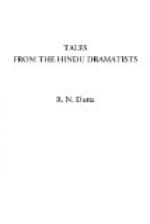BHAVABHUTI.
The name of Bhavabhuti stands high in Sanskrit literature. It is perhaps the highest in eloquence of expression and sublimity of imagination. Throughout the whole range of Sanskrit literature—from the simple lessons of Hitopadesha to the most elaborate polish of Naishadha—from the terse vigour of Sankaracharjya to the studied majesty of Magha—from the harmonious grace of Kalidasa to the ornate picturesqueness of Kadambari, there is probably no writer who can come up to Bhavabhuti in his wonderful command of Sanskrit language and surprising fluency and elevation of diction.
The introductions to the Viracharita and the Malati-Madhava tell us that he belonged to Padmapura in Vidarva (Berar) and was the grandson of Gopal Bhatta and son of Nilkantha and Jatukarni. He was descended from a family of Brahmans surnamed Udambaras.
His wonderful memory and vast erudition soon procured for him the title of Srikantha or Minerva-throated. He soon removed to the court of Ujjayini, where before the celebrated Mahakala all his plays were acted.
He wrote the Viracharita, the Uttarramacharita and the Malati-Madhava.
According to Rajatarangini, Bhavabhuti was patronized by Yasovarma, king of Kanoja. This Yasovarma was subdued by Lalitaditya, king of Kasmira, who acquired by his conquests a paramount supremacy over a large part of India.
VIRA CHARITA.
The play throws some light on the condition of women. The princesses of Videha publicly go to the hermitage of Vishvamitra. Sita comes out with her attendants to dissuade Rama from meeting Jamadagnya and makes a public entry with him on his return to Ayodhya. The old queens come out to meet their children. Yet it must not be supposed that Hindu women enjoyed the same freedom of intercourse as their European sisters. As now, there used to be separate apartments for women. As now, they were not admitted to an equality with men. The princesses of Videha do not carry on conversation with the princes of Ajodhya. Sita does not come out to pay her respects to the seniors, but her salute is announced from within. There is now more seclusion of Hindu women as the result of the influence of past Mahammedan rule. The influence of British rule is now promoting the cause of female liberty.
UTTARRAMACHARITA.
The mutual sorrows of Rama and Sita in their state of separation are pleasingly and tenderly expressed. The meeting of the father and his sons may be compared advantageously with similar scenes with which the fictions of Europe, both poetical and dramatic, abound. The true spirit of chivalry pervades the encounter of the two young princes with their father. Some brilliant thoughts occur, the justice and beauty of which are not surpassed in any literature. The comparison of Chandraketu to a lion’s cub turning to brave the thunderbolt is one of these; and another is the illustration of the effects of education upon minds possessed or destitute of natural gifts.




